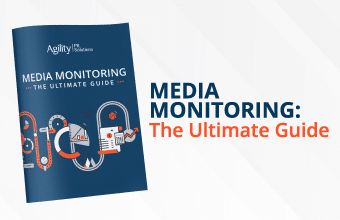How do you make important decisions?
Do you trust your gut? Poll your colleagues? Do you frantically search Google to find results from expert sources? Or maybe you’re a firm believer in shaking a Magic 8-Ball and letting fate decide.
Regardless of your approach, every decision is based on the pursuit of an outcome that will either elicit the most pleasure or avoid the most pain.
And though the pain-pleasure paradigm also rings true for decision-making in business, organizations need to look past gut feelings and Magic 8-Balls when assessing their options—they need reliable research and resources to make informed decisions that will make their business grow.
Here’s how organizations can use media monitoring and analysis for effective decision making:
Product development
The scenario
You have a product that has already seen success in the marketplace. But you’ve recently noticed that you’re quickly losing market share, because your competitors have added new features to their similar offerings.
From your research you’ve concluded that each addition is unique.
You want to adopt the most sought-after feature into your own product line, and build it out further.
What do you do?
The solution
Brand advocates play a large role in spreading the word about products and services—not only are they trusted by their audience, but they’re also major influencers of conversations within their space. Use media monitoring and analysis to track influencer conversations surrounding your offerings, as well as your competitors’, to see what is liked and disliked about them.
Which addition does your audience prefer? Do they have any criticisms, or suggestions for improvements? How does your company rank in social share of voice?
Pro Tip: Did you know that you can leverage all of your employees as media outreach ninjas?
You can use this information to plan out your product development strategy. You’ll know exactly which feature to add, and could even glean inspiration on how to improve it to surpass your competition. You may even get an idea for a feature that alleviates a common industry pain point.
Pivoting
The scenario
Your product is competing in a saturated marketplace. You’re doing well, but want to differentiate your product from the rest.
What do you do?
The solution
As Jared from Silicon Valley would say, “Let’s pivot!”
Use media monitoring and analysis to refer to your previous coverage, to then see if you can identify a new target audience or use for your product. Start by taking a look at the geography of your coverage to see if all of your content is coming from one specific area, or a new region to which you hadn’t previously considered marketing.
Next, identify what types of writers and publications are giving you the most coverage. You may have developed your product for engineers, but business writers could be providing the most reviews and use cases for it—this could be a great opportunity to brush up on your public relations skills and formally introduce your product to a new market.
Lastly, you can monitor social media to understand what’s being said about your brand and product. This information will allow you to pinpoint new uses for your product, or holes in your current product offering, that could help develop your new unique selling proposition.
Media relations
The scenario
You’ve developed your product and have identified your what makes you different from your competitors, and now it’s time to get the word out. Because your job requires you to wear many hats, you only have a certain amount of time in your day to perform media outreach. You must use this time effectively.
What do you do?
The solution
Use media monitoring and analysis to help your business identify the journalists and outlets that provide the most coverage for your organization. You can keep track of them in a spreadsheet, or by building a media list from your provider’s media database.
You can then identify which topics these journalists and publications cover most in regards to your product and industry. This information will allow you to personalize your pitch to these journalists, and to ensure you’re using your time wisely.
Lastly, use media monitoring and analysis to see what time articles are written at. This type of data will help you understand the publishing patterns of your desired journalists and publications, allowing you to time your pitches appropriately.
Pro Tip: MediaMiser has some handy tips on how to keep your media database up-to-date.
Remember, these are just a few examples of how media monitoring can help with effective decision making. If you’re looking to find out how media monitoring and analysis can help your business make important decisions, schedule a demo with us today.
Alternatively, if you’re looking for more ways that you can use media monitoring and analysis for your entire company, check out our blog post: More than just PR: A holistic approach to media monitoring.











